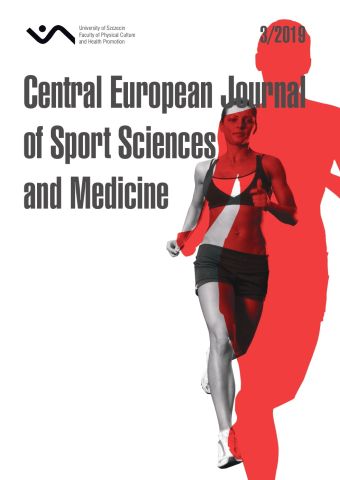
ISSN: 2300-9705
eISSN: 2353-2807
OAI
DOI: 10.18276/cej.2019.3-04




Lista wydań /
Vol. 27, No. 3/2019
The influence of functional movement screen results on the frequency of sports injuries in soccer players
| Autorzy: |
Krzysztof
Kryger
Wielkopolskie Centrum Rehabilitacji i Profilaktyki Niepełnosprawności Dzieci i Młodzieży Andrzej Wieczorek Zakład Teorii i Metodyki Zespołowych Gier Sportowych, AWF Poznań Jacek Wieczorek Zakład Teorii i Metodyki Zespołowych Gier Sportowych, AWF Poznań Robert Śliwowski Zakład Teorii i Metodyki Zespołowych Gier Sportowych, AWF Poznań |
| Słowa kluczowe: | FMS trauma risk junior players |
| Data publikacji całości: | 2019 |
| Liczba stron: | 13 (41-53) |
Abstrakt
Functional Movement Screen (FMS) is a functional screen test of the motor system which is steadily gaining recognition
and popularity among individuals interested in prevention of sports injuries. The FMS test battery includes seven mutually related
motor activities to analyse the quality of basic movement patterns. An in-depth interpretation of the performed test design
provides good conditions to determine the weakest links in the kinematic chain and to estimate the risk of injury.
The objective of this study was to determine the effect of the FMS test results on frequency of sports injuries in soccer players.
With the main objective of the study in mind the following research hypothesis was formulated: “a group of players in the lowest
interval (14–17 FMS test points) will have a high frequency of injuries in comparison to a group in the upper interval (18–21 points
in the FMS test)”. The tests were carried out on a group of 102 younger and older junior soccer players representing the Soccer
Academy of KKS Lech Poznań. For that the test design with FMS test procedure was used, followed by a six month period in
which the injuries of the individuals in the study group were recorded.
The research hypothesis was not confirmed. In the analysis of the results no statistical significance was noted between the total
number of points obtained in the FMS test and the number of injuries. It was noted that the number of injuries was statistically
significantly correlated with the results of the Shoulder Mobility test of the right side (for all participants and for the players in the
lower interval), Hurdle Step test of the left side (for a group of players in the lower interval), and the In-line Lunge test of the left
side (for upper interval players). The results of the single variable logistic regression showed that injuries occurred more often in
players of the lower interval. A forest plot indicates the direction of the increased risk of injury in players in the lower interval of
points: OR = 1.14 (95% CL; 0.71 : 1.83).
Pobierz plik
Plik artykułu
Bibliografia
| 1. | Adamczyk, G. (2005). Injuries in football. Forum Trenera, 1, 36–39. |
| 2. | Adamczyk, J.G., Pepłowski, M., Boguszewski, D., Białoszewski, D. (2012). Functional evaluation of athletes practicing weightlifting using the functional movement screen test. Medycyna sportowa, 4 (4), 267–276. |
| 3. | Bangsbo, J., Mohr, M., Krustru, P. (2006). Physical and metabolic demands of training and match-play in the elite football player. Journal of Sports Sciences, 24 (7), 665–674. |
| 4. | Główny Urząd Statystyczny (GUS) (2017). Physical Culture in Poland in 2016 yr. Warsaw. Retrieved from: https://stat.gov.pl/obszary-tematyczne/kultura-turystyka-sport/sport/kultura-fizyczna-w-polsce-w-2016-r-,12,1.html on 10 November 2018. |
| 5. | Grygorowicz, M., Głowacka, A., Wiernicka, M. (2010). Comprehensive physiotherapeutic assessment as the basis for the primary prevention of sports injuries. Nowiny lekarskie, 79 (3), 240–244. |
| 6. | Hadała, M., Bieganowski, K., Wierzbowska, C., de Bernardo Tajedor, N., Snela, S. (2006). Traumatism among football players and methods of work of the medical team in selected Polish and Spanish football clubs. Medycyna sportowa, 5 (6), 272–276. |
| 7. | Kiesel, K., Plisky, P., Butler, R. (2011). Functional movement test scores improve following standardized off-season intervention program in professional football players. Scandinavian Journal of Medicine & Science in Sports, 21 (2). |
| 8. | Kiesel, K., Plisky, P.J., Voight, M.L. (2007). Can serious Injury in Professional Football be Predicted by a Preseason Functional Movement Screen? North American Journal of Sports Physical Therapy, 2 (3). |
| 9. | Lemiesz, G., Iwańczyk, K., Biernat, R., Godlewski, J., Szymański, M., Biernat, U., Tajchman, L., Sieklucka, E. (2013). Application of the Functional Assessment test in practice. Praktyczna fizjoterapia i rehabilitacja, 39, 4–11. |
| 10. | Minick, K., Kiesel, K.B., Burton, L., Taylor, A., Plisky, P., Butler, R.J. (2010). Interrater Reliability ofthe Functional Movement Screen. Journal of Strength Conditioning Research, 24 (2) MAM. |
| 11. | Rzepka, R. (2009). Functional training and the possibilities of its use in training footballers. In: T. Grzybczak, R. Więcek, A. Stuła (eds), Theoretical and practical aspects of modern football (pp. 209–244). Opole: Politechnika Opolska. |
| 12. | Shojaedin, S.S., Letafatkar, A., Hadadnezhad, M., Dehkhoda, M.R. (2014). Relationship between functional movement screening score and history of injury and identifying the predictive value of the FMS for injury. International Journal of Injury Control and Safety Promotion, 21 (4), 355–360. |
| 13. | Tee, J.C., Klingbiel, J.F., Collins, R., Lambert, M.I., Coopoo, Y. (2016). Preseason Functional Movement Screen Component Tests Predict Severe Contact Injuries in Professional Rugby Union Players. J Strength Conditioning Research, 30 (11), 3194–3203. |
| 14. | Zalai, D., Panics, G., Bobak, P., Csáki, I., Hamar. P. (2015). Quality of functional movement patterns and injury examination in elite-level male professional football players. Acta Physiologica Hungarica, 102 (1), 34–42. |
| 15. | Żołnowski, B., Wrona-Żołnowska, L., Gębska, M., Wojciechowska, A., Żyżniewska-Banaszak, E. (2013). Traumatism of youth practicing football at the age of 15–19. Rocznik Pomorskiej Akademii Medycznej w Szczecinie, 59 (1), 120–123. |